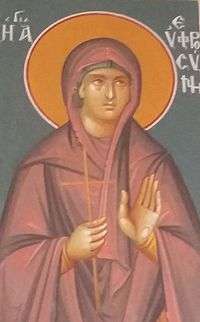Euphrosyne of Alexandria

.jpg)
Saint Euphrosyne of Alexandria (Greek: Ἁγια Ευφροσύνη) (fl. 5th century CE) fled an advantageous marriage by adopting male attire and taking up residence in a local monastery as a celibate ascetic.
Her "life", narrated in the Vitæ Patrum, has some unmistakable hallmarks of the sentimental Hellenistic novel. Euphrosyne was the beloved only daughter of a rich man of Alexandria, miraculously born in her parents' old age in answer to a monk's prayer. Her loving father, Paphnutius, desired to marry her to a wealthy youth. But having already consecrated her life to God and under pressure to break this vow, she clothed herself as a man and, as "Smaragdus," a name meaning 'emerald,' gained admittance to a monastery nearby. There she made rapid strides toward a perfected ascetic life, under the guidance of the abbot, who was the very monk who had prayed for her birth. When her own father appealed to the abbot for comfort in his bereavement, the abbot committed him to the care of the alleged young man. The father received from his own daughter, whom he also failed to recognize, helpful advice and comforting exhortation. Not until she was dying did Euphrosyne reveal herself to him as his lost daughter. Her feast is celebrated both in the Catholic and Eastern Orthodox churches. Feast day 25 September,.[1][2]
References
Notes
| Wikimedia Commons has media related to Euphrosyne of Alexandria. |
![]() This article incorporates text from a publication now in the public domain: Herbermann, Charles, ed. (1913). "article name needed". Catholic Encyclopedia. New York: Robert Appleton.
This article incorporates text from a publication now in the public domain: Herbermann, Charles, ed. (1913). "article name needed". Catholic Encyclopedia. New York: Robert Appleton.